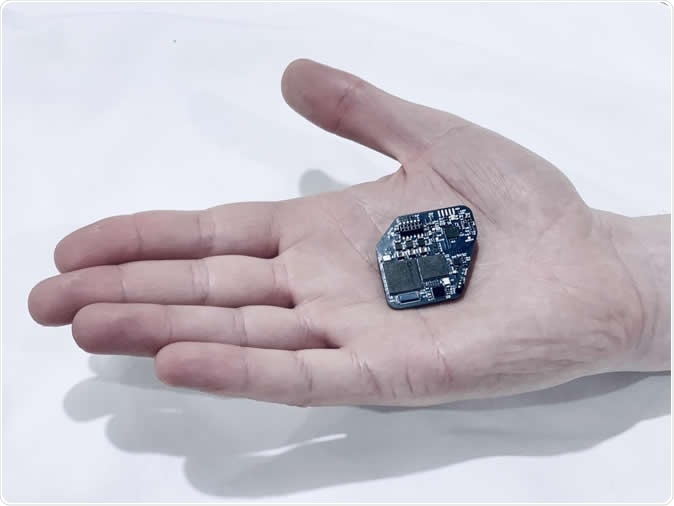Engineers and researchers at the University of California, Berkeley have developed a neurostimulator that can act as a pacemaker within the human brain. This device could detect the electrical currents within the brain and also deliver brain stimulation into the brain. This form of neurological stimulation could help patients with epilepsy and Parkinsonism, the team explains.
The results of the experiments trying the new device were published in a study that appeared in the latest issue of the journal Nature Biomedical Engineering.

In a proposed device, two of the new chips would be embedded in a chassis located outside the head. Each chip could monitor electrical activity from 64 electrodes located into the brain while simultaneously delivering electrical stimulation to prevent unwanted seizures or tremors. Image Credit: Rikky Muller, UC Berkeley
The team has named the device WAND that stands for, “wireless artifact-free neuromodulation device,” and have called it the pacemaker for the brain. The researchers explain that in diseases such as epilepsy, there is an abnormal electrical activity within the brain that causes a firing across the brain which leads to whole brain involvement and seizures. Patients with tremors and other movement disorders too have abnormal brain electrical activity. Before these seizures or movement disorders are seen, there are minor triggers and these electrical signatures are often difficult to detect. The frequency of electrical stimulations that are needed to prevent these minor triggers are known to be equally tricky and low voltage. Multiple adjustments are necessary to provide optimal treatment to patients so that they benefit from the.
WAND is a device that is wireless as well as autonomous. This means that the device can pick up the subtle signs of an impending tremor or seizure from the minor electrical activities of the brain. Thereafter the device can regulate the amount of stimulation it would provide to counteract the electrical signals of the brain. This can prevent the unwanted movements as well as the seizures. The detection as well as the stimulation is all recorded by the device and thus can be adjusted with each signal.

The WAND chip is designed with custom integrated circuits that can record the full signal from both subtle brain waves and strong electrical pulses delivered by the stimulator. Image Credit: Rikky Muller, UC Berkeley
Rikky Muller Assistant Professor of electrical engineering and computer sciences at Berkeley explained, “The process of finding the right therapy for a patient is extremely costly and can take years. Significant reduction in both cost and duration can potentially lead to greatly improved outcomes and accessibility. We want to enable the device to figure out what is the best way to stimulate for a given patient to give the best outcomes. And you can only do that by listening and recording the neural signatures.” The device can record electrical activity over 128 channels or points across the brain. Other systems that have been developed previously could record from only eight channels. The deep brain stimulators at present can provide electrical stimulations but stop recording when they do so. This means that vital signals may be missed. WAND on the other hand keeps recording even while provoding the stimulation.
The team used experimental rhesus macaques and used WAND to delay specific arm movements in the animals. Researchers at Cortera Neurotechnologies, Inc., have developed the integrated circuits of the WAND that could record the brain signals from both sides of the brain and also the electrical pulses. The chip on the device can separate the electrical pulses within the brain and the normal brain waves. Muller explained, “Because we can actually stimulate and record in the same brain region, we know exactly what is happening when we are providing a therapy.” The team worked in collaboration with the lab of electrical engineering and computer science professor Jan Rabaey.
Muller speaking of their experiment with the macaques said, “While delaying reaction time is something that has been demonstrated before, this is, to our knowledge, the first time that it has been demonstrated in a closed-loop system based on a neurological recording only... In the future we aim to incorporate learning into our closed-loop platform to build intelligent devices that can figure out how to best treat you, and remove the doctor from having to constantly intervene in this process.”